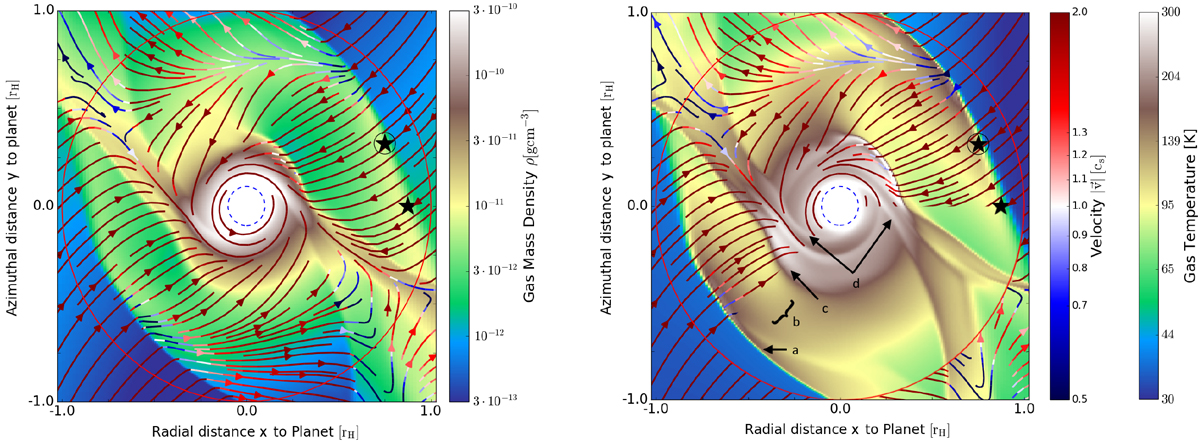Fig. 3

Overview of flow structures in the midplane of the nominal simulation run C1 after reaching steady state at orbit 5. Density (left) and temperature (right) values in the midplane are shown along with the gas streamlines coloured according to Mach number. While streamlines in all generality do not coincide with the gas motion, they do so in steady-state. Gas coming from the circumstellar disc encounters the spiral arms in the midplane, which are heavily modified by the ongoing accretion process and non-isothermal modification of the planetary Hill sphere. The rotationally supported disc is formed mainly between
![]() and
and ![]() . This disc contains its own structures, such as a midplane accretion shock from the supersonically infalling gas and smaller CPD spiral arm shocks. Arrows target the features, not specific points. The letter-labels refer to the CSD spiral arm (a), free-fall region (b), CPD accretion shock (c), and CPD spiral arm (d). The black stars denote the positions where streamlines of interest cut through the spiral arm shock. These positions are constant in 3D-space, and will serve as orientation points when investigating the vertical direction. We note the highly supersonic flows which remain supersonic after encountering the spiral arm shock. This is due to insufficient static shock pressure, which is advecting the spiral arm radially inwards. The spiral arm mass is replenished from the vertical direction.
. This disc contains its own structures, such as a midplane accretion shock from the supersonically infalling gas and smaller CPD spiral arm shocks. Arrows target the features, not specific points. The letter-labels refer to the CSD spiral arm (a), free-fall region (b), CPD accretion shock (c), and CPD spiral arm (d). The black stars denote the positions where streamlines of interest cut through the spiral arm shock. These positions are constant in 3D-space, and will serve as orientation points when investigating the vertical direction. We note the highly supersonic flows which remain supersonic after encountering the spiral arm shock. This is due to insufficient static shock pressure, which is advecting the spiral arm radially inwards. The spiral arm mass is replenished from the vertical direction.
Current usage metrics show cumulative count of Article Views (full-text article views including HTML views, PDF and ePub downloads, according to the available data) and Abstracts Views on Vision4Press platform.
Data correspond to usage on the plateform after 2015. The current usage metrics is available 48-96 hours after online publication and is updated daily on week days.
Initial download of the metrics may take a while.


